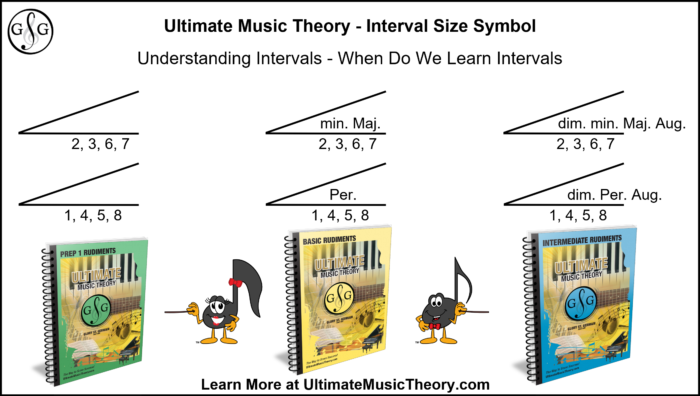Intervals – Size Symbol

Mnemonic Devices are signs and symbols that support remembering a concept, word or idea. In the Ultimate Music Theory Workbooks, Mnemonic Devices, including the Interval Size Symbol (the "crescendo" with the numbers in it), are used to help you remember specific Musical Concepts.
UMTC Certified Teacher Connie Seward wrote "I am having trouble understanding the significance of the intervals inside of a crescendo or increase mark? Would you mind explaining?".
I would love to Connie! Here is what the Interval Size Symbol of a "crescendo" sign means (and why we uses it).
Intervals - Size Symbol - What is an Interval?
An Interval is the distance in pitch between two sounds. The Interval Distance is indicated by a Number (1st, 2nd, 3rd, etc.). The Interval Quality is indicated by a term (Major, minor, Perfect, etc.).
An Interval Distance can change step by step (chromatic half step/chromatic semitone) to adjust the Quality of the Interval.
Remember to go to UltimateMusicTheory.com and search our Blogs. When you type "Intervals" in the "search our Blog" space, you will find a number of Blogs to support you learning about intervals, and how to teach intervals to our students.
Intervals - Size Symbol - Where are the Intervals From?
Intervals are based upon the notes of the Major Scale of the lowest/bottom/low note. (Remember, this may not be the first note! So, be careful to reinforce that the information for the Interval always comes from the Major Scale of the lowest note.
Major Intervals are intervals of a 2nd, 3rd, 6th and 7th. These intervals are always based upon the notes of the Major Scale of the lowest note of the Interval.
- An Augmented Interval can become one half step smaller to become Major;
- A Major Interval can become one half step smaller to become minor;
- A minor Interval can become one half step smaller to become diminished.
Perfect Intervals are intervals of a 1st, 4th, 5th and 8th. These intervals are always based upon the notes of the Major Scale of the lowest note of the Interval.
- An Augmented Interval can become one half step smaller to become Perfect;
- A Perfect Interval can become one half step smaller to become diminished.

Remember - the smallest interval is a Perfect Unison - a Perfect First. There is no such interval as a diminished 1st! If you are not certain why, read the blog "No Diminished First"!

Interval Size Symbol - Similarity Between Music and Math
In Math, the "Greater Than" Symbol (the > symbol) is used to indicate that the number on the left of the symbol is larger or "greater than" the number on the right of the symbol.
For example, in Math: 7 > 4 means that the number 7 is greater than (larger than) the number 4.
In Math, the "Less Than" Symbol (the < symbol) is used to indicate that the number on the left of the symbol is smaller or "less than" the number on the right of the symbol.
For example, in Math: 5 < 8 means that the number 5 is less than (smaller than) the number 8.
In Music, when an Interval moves to become bigger (greater than), the movement is to the "right" in the Interval Size Symbol. This is represented by the 2 lines of the Interval Size Symbol becoming larger as they move to the "right".
- For Intervals of a 2nd, 3rd, 6th and 7th, moving from left to right (from smaller to larger), diminished becomes minor; minor becomes Major; Major becomes Augmented.
- For Intervals of a 1st, 4th, 5th and 8th, moving from left to right (from smaller to larger), diminished becomes Perfect; Perfect becomes Augmented.
In Music, when an Interval moves to become smaller (less than), the movement is to the "left" in the Interval Size Symbol. This is represented by the 2 lines of the Interval Size Symbol becoming smaller as they move to the "left".
- For Intervals of a 2nd, 3rd, 6th and 7th, moving from right to left (from larger to smaller), Augmented becomes Major; Major becomes minor; minor becomes diminished.
- For Intervals of a 1st, 4th, 5th and 8th, moving from right to left (from larger to smaller), Augmented becomes Perfect; Perfect becomes diminished.
The Interval Size Symbol "Crescendo" reminds Students that movement to the right (to the larger, open end of the Size Symbol) means that Intervals are becoming bigger (larger) as they move in that direction. Movement to the left (to the smaller, closed end of the Size Symbol) means that Intervals are becoming smaller as they move in that direction.

Interval Size Symbol - When Do We Learn Intervals
In the Ultimate Music Theory Prep 1 Rudiments Workbook and the Prep 2 Rudiments Workbook, Students learn to read Intervals by number size. Directional Arrows are used to indicate direction for Melodic (Separate) intervals.
In the Ultimate Music Theory Basic Rudiments Workbook, Students discover how Intervals are written based on the notes of the Major Scale of the lowest note. Intervals of a 2nd, 3rd, 6th and 7th are identified as Major or minor. Intervals of a 1st, 4th, 5th and 8th are identified as Perfect only.
In the Ultimate Music Theory Intermediate Rudiments Workbook, Students add the qualities of Diminished and Augmented.
Now, there is another Device called the "Karate Chop" that supports Students in understanding Interval Movement. This "Karate Chop" Method is introduced in the Ultimate Music Theory Certification Course. This Course is a MUST for Teachers who want to learn how to Teach Theory.
In the UMT Certification Course, you will learn all kinds of Mnemonic Devices and Teaching Strategies that will support teaching Students of ALL Learning Styles! It really is a teaching game changer!

Ultimate Music Theory Certification Course Online Teacher Training includes: 50 Video Sessions, All Materials, Online Support,
Exam Marking & Certificate!
Click HERE to discover what you will learn in the Ultimate Music Theory Certification Course. Your professional development Online Teacher Training starts here.
Ultimate Music Teachers Membership
♪ LEARN ♪ PLAN ♪ TEACH ♪ GROW
The One & ONLY Ultimate Music Teachers Membership
To Become A UMT PRO!
Your Success Path Starts Here - Go To TeachUMT.com Today!
Keep on Learning... With a Smile and a Song!
Shelagh McKibbon-U'Ren


